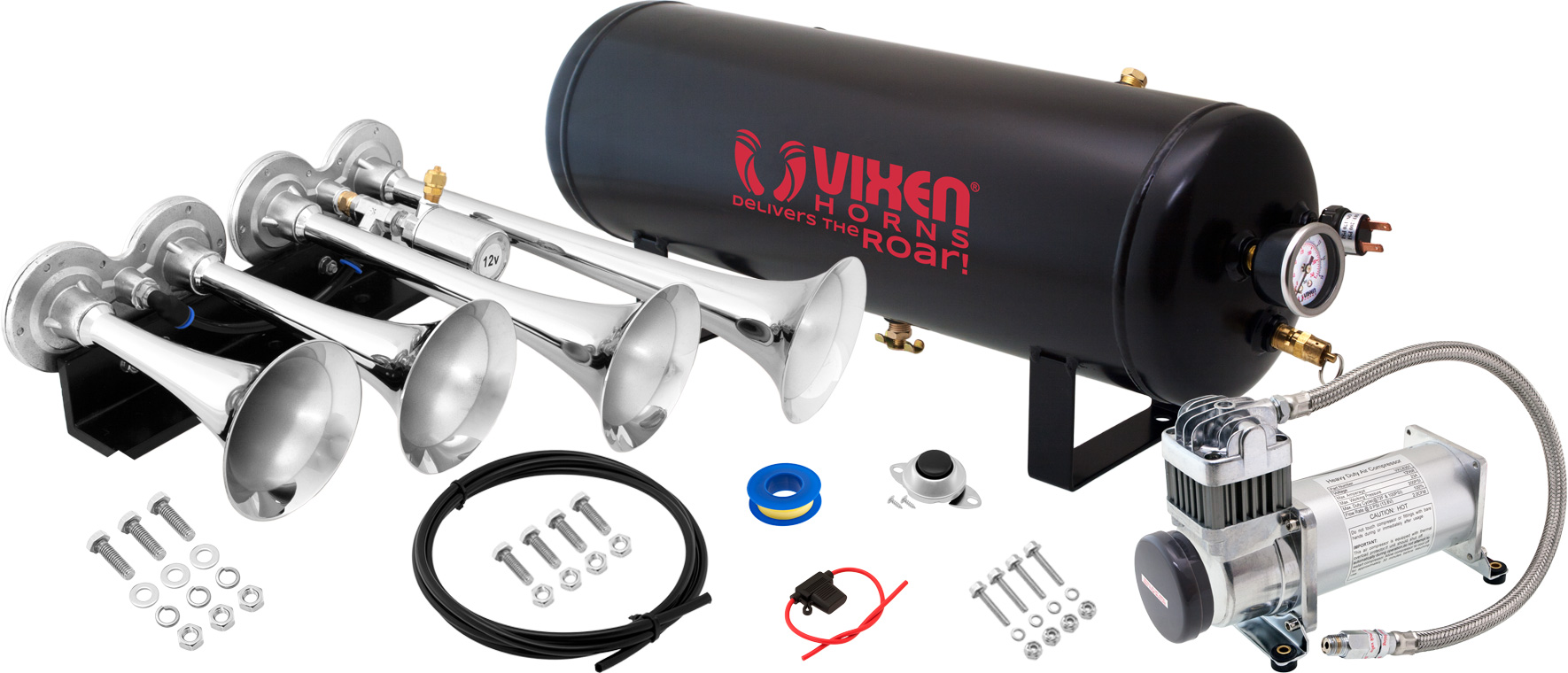Glossary of Terms
Air System
Air Compressor
A mechanical device that increase the pressure of air by reducing its volume. Vixen Horns compressors have two main components: an electric motor body, and a piston assembly. The electric motor runs on a 12V power supply to drive the piston. Air is obtained from the atmosphere and pumps it into the air tank. These compressors are compact, efficient and require very little or no maintenance.
Duty Cycle
Refers to the amount of time a compressor can be operated in a given time period (usually 1 Hour), at 100 PSI and standard ambient temperature of 72°F. Because of the heat compressors produces during the duty cycle is necessary for them to stop to cool down in order to continue operation. Low duty cycle compressors will have higher CFM output, perfect for burst applications such as train horns while high duty cycle compressors of the same class will have a lower CFM output, which is good for constant slow fill applications like air bags.
Working Pressure
Represent the maximum pressure the compressor can produce in the air tank during normal wear. A pressure switch is used always in conjunction with the air compressor and his cut-off pressure must never be higher than the maximum working pressure of the compressor.
CFM @ PSI
Compress air volume produced by the compressor, typically measured at two different air pressures, 0 PSI (no resistance) and at 100 PSI (with resistance). These two values helps you determine the slowdown of compressors functionality while the pressure resistance increase in the tank.
Air Filter (Inlet)
Most air compressors have filters that prevent dust and debris entering the intake duct. These filters can be installed on the compressor itself or in a remote location depending on the model. To prolong compressor’s life span, the filter must never be installed near a source of debris, vapor, or liquid; and should be replaced regularly in relation to the compressor’s usage.
Air Tank
An important part in an air system, it serves as a reservoir for the air that is pumped by the compressor. Tank’s size should be chosen depending of the air consumption of devices you are planning to use with. Using a low volume air tank with a high demanding device can lead to failure.
Working Pressure
The maximum pressure a tank can withstand during normal use. Exceeding this pressure may damage the tank and could possible cause harm to users.
Burst Pressure
Rated higher than the working pressure, this value represents the pressure in which the tank’s connecting lines can burst. This number is only for reference, never pressurize tanks over the working pressure.
NPT Port
NPT (National Pipe Threading) ports are standardized ports for water and air lines. NPT fittings must be used with NPT ports. Using different standards will damage the threads.
Air Horn
A horn that works when compressed air travel onto a diaphragm, and then resonates the air on its exit from the horn bell.
Diaphragm
A metal or plastic disc located inside the horn’s base which resonates the air traveling through the horn. Because compressed air contains moisture is very important the material used for the diaphragm.
Air Consumption
Every time the air horn is activated it consumes certain amount of compressed air and is measured in CFM, the higher this value is the more air will use by second. High consumption horns should be paired with larger capacity air tanks.
Decibel
This value measure only the pressure of a sound wave and not its power. The power of a sound wave is approximately the square of its pressure. Two air horns can have the same decibel rating but output a more or less focused wave, usually bigger horns produce less focused wave but output higher volumes so they can be heard from farther away and in less focused areas.
Pressure Switch
A device that provides power to the compressor until the cut-off pressure is reached in the air tank, preventing the compressor and other devices connected to the air system from working above its maximum working pressure. Pressure switches must be fused properly.
OFF Pressure
The pressure at which the switch open and cut power to the compressor. This pressure should never be higher that the working pressure of the compressor it is powering or any devices connected to the air system.
ON Pressure
The pressure at which the switch close and begins supplying power to the compressor until the cut-off pressure is reached.
Air Valve
When triggered by an electrical signal this valve opens up and let the air flow from the air tank to the device connected to it, in our case an air horn.
Working Pressure
The maximum pressure the air valve can withstand during normal use. Exceeding this pressure may damage the valve and could possible cause harm to users.




